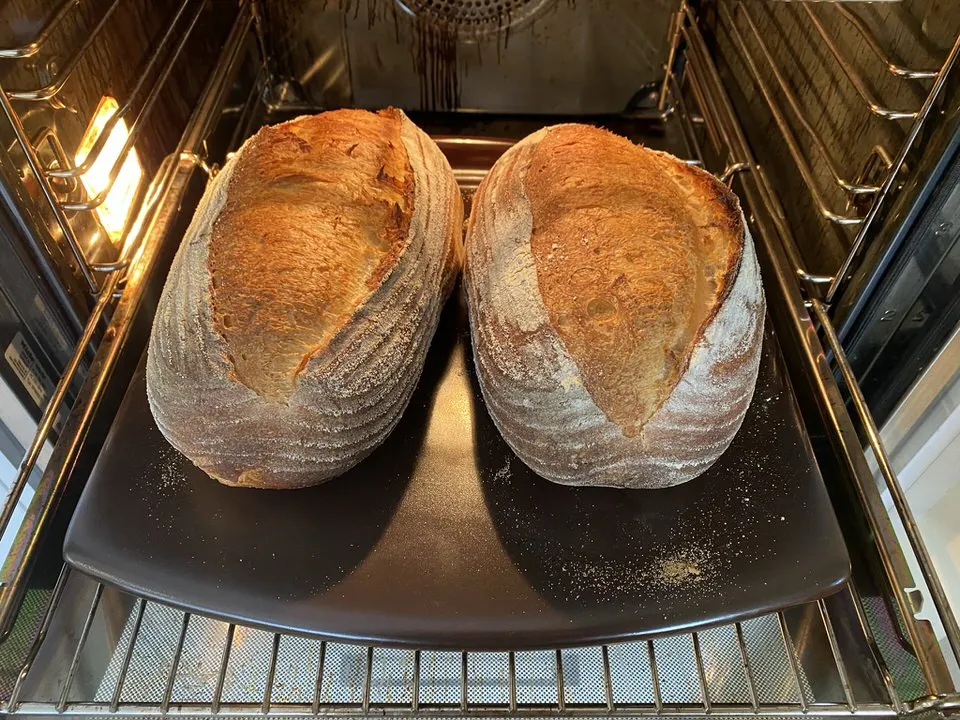Many tutorials show bread formed & baked freeform resulting in a round loaf.
What is the advantage of baking freeform, if any (other than aesthetics)?
When I began baking bread I didn’t have a tin & I produced many pancake-shaped loaves. I tried numerous techniques to avoid the dough flattening. Many didn’t work & the few that did were very inconsistent.
One day a friend bought me a bread tin. I tried it out & from that day forward my loaves have been successful.
They always have great spring with a decent crust & the slices are of uniform size & shape.
I occasionally try a freeform loaf but 9 times out of 10 they always fall flat so I return to my tin.
Other than aesthetics (yes, they look great) I can think of no advantages to baking freeform. In fact, for sandwiches & toast a tinned loaf is better inasmuch as the slices are the same shape & size whereas the middle slice of a freeform loaf is bigger than the others & won’t fit in the toaster.
As you may have gathered, I want to eat the bread, not look at.
Your thoughts?
Yes! I am firmly in the Pullman camp. I mostly use them with the lid off.
I would be on your camp as well Gary. Here is a pan loaf I baked today.
Wouldn't your "freeform" loaf need a mold of some sort? As long as you use a "mold" to proof a loaf it wouldn't be a true
"freeform loaf" in my opinion. I make baguettes without using any mold and these I would consider are truly free standing loafs.
I proof my free form loaves in bannetons, and my baguettes in a cloth couche. Both are turned out onto a peel and loaded into the oven to bake on a stone with steam. They are free form if unsupported in the oven.
Good to know Gavin, thanks for chiming in my friend.
It's all up to you. I really like the look of free form loaves, and also prefer the crust I get on them. And sometimes using a tin might feel like cheating :)
But you do you, nothing wrong with a pan loaf!
Whatever floats your boat! Enjoy!
To me, choosing tinned vs freeform is a practical choice. Square pieces fit better into toasters, lunch bags, bento boxes,etc. Generally, tinned loaves have a closer crumb-i.e. better for sandwiches. But if you are using your slice or chunk of bread to dunk into soup/stew, a boule (even if it is pancaked), might be a better choice. If I want a crusty sandwich, I can form a batard into any diameter I want and have a great,crusty sandwich.
So whatever floats your boat or matches the use- that is the best bread for you!
There's no hard and fast rule; just do what you prefer. I only use a Pullman pan when baking a sandwich loaf. My sourdoughs, (batards and boules) are baked free form on a stone with steam for first 15 minutes and finished in a drying oven. I get very good oven spring with a nice even crispy crust all over. They slice nicely for the toaster.
Image

Gavin, that's an interesting looking stone. Could you please tell me what brand it is? Thanks.
Dave
Hi Dave. The stone is a Miele. They are in two sizes to suit the oven width.
Gavin
Thank You!
Dave
Gavin thanks for the pic, interesting stone;
I use a baking steel (30cm X 30cm), and I also like to bake two loaves at once, so found it interesting that your loaves are as close together as mine are. Do you also have a problem with them expanding ("kissing") into each other? I've taken opening the oven 5 minutes after loading and separating them with a large knife, but wondered how you got yours to not coalesce.
-Jon
I usually have a bit more of a gap separating them. Occasionally they kiss together, but I leave them alone until out of the oven.
Gavin
Both are great! It doesn't have to always be one or the other!
One thing that is different is the baking temperature - my loaf pans all have some sort of non stick coating so I try and not exceed 200C.
Also, I find that pan loaves don't get as much crispy crust as hearth breads, for various reasons.
-Jon
For the last 40 or so years all my breads, with the exception of buns and rolls, were baked free form on a stone. Then at the end of last year my wife bought me some USA pans because she wanted me to bake a "cocktail" type rye. Since then I've only baked in pans. Just recently got USA Pullman pans and enjoy using them the most, although my loaves are not Pain de Mie loaves. They are more dense loaves at around 30% to 40% whole grain.
I get a good crusty loaf by removing the loaves from the pans for the last 25 minutes of baking. Total time is around 55 minutes for a good full bake. Pictures of my earlier pan loaves done in a 9" x 5" pan.
Dave
I retard and bake in stoneware loaf plans lined with parchment paper. They have no problems with high temperatures. Before putting in the oven, I score, mist, and cover with upside-down metal loaf pans. After thirty minutes in the oven, I remove the metal loaf pans and cook about 30 more minutes. Then I take the pans out of the oven, remove the loafs and parchment paper, and then put the bare loaves back in the oven to finish baking (when the loaves are 200F). I live at 6200 feet so my baking times are longer than typical.